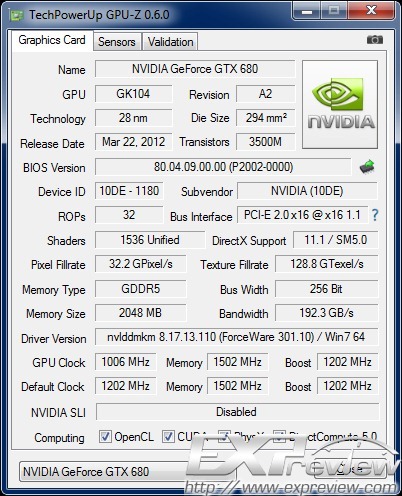
We should address a couple of tricky issues instead.įirst, although the GTX 670 looks like it might be something folks would want to buy, there is a question lingering over its head: will there be a sufficient supply of cards in the market? Since its launch, the GTX 680 has been flashing in and out of stock at online retailers very quickly, as shipments of cards arrive and then sell out quickly. We won’t linger, now that our specs table quotas have been fulfilled. Anyhow, it’s best not to compare these numbers across different architectures and pretend they’ll reliably predict real-world performance. Against the Radeon HD 7950, the comparison becomes complicated in a hurry because both cards have pronounced advantages in certain categories. We’re eager to test this card once, you know, it makes it here.Įven if you crunch the numbers based on the card’s bone-stock base clock frequency, the GTX 670 looks to be considerably more powerful than Nvidia’s prior-gen top-o’-the-line offering, the GeForce GTX 580, in every category but memory bandwidth (a tie) and ROP rate (where the 580’s faster). The cooler looks like the same snazzy one on Zotac’s GTX 680 AMP!, from which we’ve seen good things. Since Zotac’s list price for the GTX 670 AMP! is $449, we think the stock GTX 680 might want to start looking for new employment. The performance of this thing is almost certain to eclipse a stock-clocked GeForce GTX 680’s, given those numbers. Zotac tells us this puppy will have base and boost clocks of 10MHz, respectively, with 6.6GT/s memory. Here’s a picture of a Zotac GTX 670 AMP! card that is purportedly making its way to us right now via an unfortunately slow shipping method. Board makers will also take things in the other direction, of course, offering higher-clocked variants with beefier cooling. Nvidia does expect video card makers to do some nice things with its teensy-weensy reference PCB design, though, including shorter cards intended for small-form-factor enclosures and possibly some single-slot coolers. The cooling shroud protrudes to 9.5″, like a pair of platform shoes, attempting to keep the GTX 670 from looking like something you’d find in a cut-rate Dell. The board is only about 6.75″ inches long, shorter than the world’s tolerance for Nickelback. The card’s max power draw is rated at only 170W-versus 200W for the Radeon HD 7950-and, well, have a look at the thing. Having said that, we should point out the GTX 670 is still made up of some relatively lightweight hardware. Looks to us like Nvidia is positioning itself pretty aggressively against the Radeon HD 7950. Although the gap between the two cards’ base clocks is a bit larger, the boost clock is probably the more important of the two it’s closer to the GPU’s typical operating speed.Īll in all, we suspect the GTX 670 may not trail the GTX 680 much at all in real-world performance. (Frankly, memory bandwidth and ROP rate are two of the places where we’d expect the GK104 GPU to be relatively weak, in the grand scheme of things.) Also helpful: the GTX 670’s boost clock is 980MHz, not far from the GTX 680’s boost clock of 1058MHz.

The GTX 670 still has all 32 ROP units intact, preserving its anti-aliasing power, and its memory interface is still 256-bits wide at 6Gbps, just like the GTX 680. They’ve nuked one of the GK104 chip’s eight SMX units and reduced clock speeds, but the cuts don’t go terribly deep. Those chances are bolstered by the fact that Nvidia’s cuts to the GTX670’s specifications aren’t likely to hurt too much. The GTX 670 has a chance to be pretty popular. That’s getting into territory where a lot more folks might feel inclined to justify the expense.

Math is fun do it with me: the GTX 680 lists at $499, so the GTX 670 will sell for $399. Nvidia has dialed back the specifications just a bit versus the GTX 680 and sliced 100 bucks off of the price. There’s no magic to the GTX 670’s appeal. As you might have cleverly deduced, the GTX 670 is a cheaper, somewhat down-spec version of the mighty GeForce GTX 680, which is itself a pretty darned desirable video card. Source: Nvidiaīesides, we wouldn’t want to miss this one, because the GeForce GTX 670 is sure to be the most broadly attractive product yet in the 600 series. Nvidia’s GeForce GTX 670 reference design.

But then I realized, hey, that’s why God made caffeine.

After posting my GeForce GTX 690 review just yesterday, I had half a mind to delay this review and give myself a breather. Yes, today marks the introduction of yet another new graphics card, as Nvidia fills out its GeForce GTX 600 series.
#Nvidia gtx 680 amp Pc#
The new PC hardware releases have been coming at us so fast lately, we haven’t been able to keep up.


 0 kommentar(er)
0 kommentar(er)
